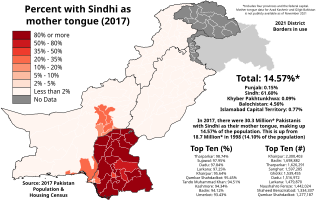
Brahui is a Dravidian language spoken by the Brahui people who are mainly found in the central Balochistan Province of Pakistan, with smaller communities of speakers scattered in parts of Iranian Baluchestan, Afghanistan, and Turkmenistan and by expatriate Brahui communities in Iraq, Qatar, and the United Arab Emirates. It is isolated from the nearest Dravidian-speaking neighbouring population of South India by a distance of more than 1,500 kilometres (930 mi). The Kalat, Khuzdar, Mastung, Quetta, Bolan, Nasirabad, Nushki, and Kharan districts of Balochistan Province are predominantly Brahui-speaking.

Balochi is a Northwestern Iranian language, spoken primarily in the Balochistan region of Pakistan, Iran and Afghanistan. In addition, there are speakers in Oman, the Arab states of the Persian Gulf, Turkmenistan, East Africa and in diaspora communities in other parts of the world. The total number of speakers, according to Ethnologue, is 8.8 million. Of these, 6.28 million are in Pakistan.

The Baloch or Baluch are a nomadic, pastoral, ethnic group which speaks the Western Iranic Balochi language and is native to the Balochistan region of South and Western Asia, encompassing the countries of Pakistan, Iran, and Afghanistan. There are also Baloch diaspora communities in neighbouring regions, including in Central Asia, and the Arabian Peninsula.

Pakistan is a multilingual country with over 70 languages spoken as first languages. The majority of Pakistan's languages belong to the Indo-Iranian group of the Indo-European language family.

Sindhi is an Indo-Aryan language spoken by about 30 million people in the Pakistani province of Sindh, where it has official status. It is also spoken by a further 1.7 million people in India, where it is a scheduled language, without any state-level official status. The main writing system is the Perso-Arabic script, which accounts for the majority of the Sindhi literature and is the only one currently used in Pakistan. In India, both the Perso-Arabic script and Devanagari are used.

Lasbela District is a coastal district in Kalat Division of Balochistan, Pakistan.

Khetrānī, or Khetranki, is an Indo-Aryan language of north-eastern Balochistan. It is spoken by the majority of the Khetrans, an ethnolinguistic tribe that occupies a hilly tract in the Sulaiman Mountains comprising the whole of Barkhan District as well as small parts of neighbouring Kohlu District to the south-west, and Musakhel District to the north. Alternative names for the language attested at the start of the 20th century are Barāzai and Jāfaraki.
The Balochs of Sindh,, is a community of Sindhi-speaking Baloch tribes living throughout the Sindh province of Pakistan.

The Baloch diaspora refers to Baloch people, and their descendants, who have immigrated to places outside the Balochistan region of South-West Asia – a region stretching from southwestern Pakistan to southeastern Iran and southern Afghanistan. The Baloch diaspora is found throughout the Middle East, South Asia, Turkmenistan, East Africa, Europe, North America and in other parts of the world.

The Balochs of Punjab are a community of Saraiki and Punjabi-speaking tribes of either full or partial Baloch descent settled in the Punjab province of Pakistan. The majority of which live in southern Punjab, including Dera Ghazi Khan and Rajanpur, which adjoin the province of Balochistan. Numerous of which no longer speak Balochi and instead speak Punjabi, Saraiki and Sindhi.
The Baluch is a Muslim community found in the state of Uttar Pradesh, India. They are descended from Baloch tribesmen who settled in this region of North India in the late Middle Ages. The community use the surname Khan, and are often known as Khan Baloch
Pakistan is an ethnically and linguistically diverse country. The major Pakistani ethnolinguistic groups include Punjabis, Pashtuns, Sindhis, Saraikis, Muhajirs, Balochs, Hindkowans/Hazarewals, Brahuis, and Kohistanis with significant numbers of Shina, Baltis, Kashmiris, Paharis, Chitralis, Torwalis, Hazaras, Burusho, Wakhis, Kalash, Siddis, Uzbeks, Nuristanis, Pamiris and various other smaller minorities.
Faiz Mohammad Faizok, was a Balochi folk musician and folk singer.

Jaḍgālī is an Indo-Aryan language spoken by the Jadgal, an ethno-linguistic group of Pakistan and Iran also spoken by few hundreds in Oman. It is one of only two Indo-Aryan languages found on the Iranian plateau. It is a dialect of Sindhi language most closely related to Lasi.

Dehwari is a southwestern Persian language spoken by 19,000 Dehwar people in Balochistan, Pakistan as of 2018. Most of the Dehwari speakers are concentrated in Mastung, Khuzdar, Nushk, Kharan, Sarlath District, Dalbandin, and Kalat.

Baloch people in the United Arab Emirates comprise citizens and residents of the United Arab Emirates of Baloch ancestry, whose ancestral roots lie in Balochistan like Balochs in other Gulf states. They often bear the surname Al-Balushi or Al-Baluchi, As some of them bear surnames of Baluchi tribes such as Al-Raeesi, Al-Huoti, Al-Ameeri or Taherzai.
The culture of Balochistan, or simply Baloch culture, is defined in terms of religious values, Balochi and Brahui language, literature and traditional values of mutual respect. It has its roots in the Balochi, Brahui, Sindhi, and Pashto. Folk music, Balochi handicrafts, drama and Balochi cinema play a significant role in Baloch culture. Quetta, the provincial capital of Balochistan, has several historical monuments such as Pirak, the Chaukhandi tombs and the Quaid-e-Azam Residency.

Lasi, or Lassi, also called Kohistani is a dialect of the Sindhi language spoken on the western frontier of Sindh and Balochistan in Pakistan. It is spoken by the Sindhi Lasi people of Lasbela, Hub and Gwadar in Balochistan, and Lasi is also spoken in the Kohistan region of Karachi, Thatta and Jamshoro districts of Sindh.

Sindhi Bhil, is an Indo-Aryan dialect spoken in the Pakistani province of Sindh, as well as some parts of Balochistan. Sindhi Bhil is often referred to as a Sindhi dialect rather than a separate language alongside Lasi.
The Rakhshani are a major Brahui-Baloch tribe who live in Pakistan and Iran. They mostly live in Qalat and Lasbela, which is located in the Rakhshan Division.













